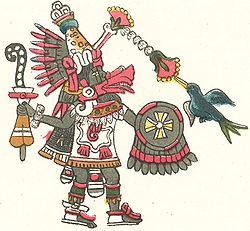|
Fingerprints of the Gods
Fingerprints of the Gods: The Evidence of Earth's Lost Civilization is a 1995 pseudoarcheology[1][2] book by British writer Graham Hancock. It contends that an advanced civilization existed on Antarctica during the last ice age, until the continent supposedly suddenly shifted south to its current position. The author proposes that survivors of this cataclysm passed on their profound knowledge to cultures around the world, giving rise to the earliest known civilizations. The idea is a form of hyperdiffusionism that is largely based on the work of Ignatius L. Donnelly and Charles Hapgood.[3] The book was followed by Magicians of the Gods.[4] Thesis Hancock argues for a civilisation centered on Antarctica (which lay farther from the South Pole than today) that supposedly left evidence (the "fingerprints" of the title) in Ancient Egypt and American civilisations such as the Olmec, Aztec and Maya. Hancock discusses:
Hancock suggests that in 10,450 BC, a major pole shift took place. Before then, Antarctica lay farther from the South Pole than today, and after then, it shifted to its present location. The pole-shift hypothesis hinges on Charles Hapgood's theory of Earth Crustal Displacement.[7] Hapgood had a fascination with the story of Atlantis and suggested that crustal displacement may have caused its destruction. His theories have no supporters in the geological community, where the accepted model is plate tectonics, but they were adopted by Rand and Rose Flem-Ath's When the Sky Fell: in Search of Atlantis (1995/2009) in which they expand the evidence for Charles Hapgood's theory of earth-crust displacement and propose Antarctica as the site of Atlantis.[non-primary source needed] ReceptionMembers of the scholarly and scientific community have described the proposals put forward in the book as pseudoscience and pseudoarchaeology.[8][9] Canadian author Heather Pringle has placed Fingerprints specifically within a pseudo-scientific tradition going back through the writings of H.S. Bellamy and Denis Saurat to the work of Heinrich Himmler's notorious racial research institute, the Ahnenerbe, and the "crackpot theories"[This quote needs a citation] of Nazi archaeologist Edmund Kiss. Pringle draws attention to Fingerprints' "wild speculations" on the origins of Tiwanaku and describes Hancock as a "fabulist".[6] Kenneth Feder said that the book reads like the "Victorian travelogue" of a writer untrained in archeology, who credits a mysterious white people for the achievements of the ancient civilizations he visits, Hancock notably referring to the Maya as "jungle-dwelling Indians" who could not possibly come up with a sophisticated calendar. Feder finds Hancock's synthesis of a variety of fringe writers such as Ignatius Donnelly, Charles Hapgood, Arthur Posnansky, Robert Bauval and Anthony West "very hard to swallow, indeed."[10] Fingerprints of the Gods has been translated into 27 languages and is estimated to have sold five million copies around the world.[11] Hancock responded to some of his critics with an updated edition of the book published in 2001 with a new introduction and new appendices, Fingerprints of the Gods: The Quest Continues.[non-primary source needed] InfluenceFingerprints of the Gods was cited as an inspiration for the 2009 disaster film 2012.[12] In a November 2009 interview with the London magazine Time Out, the film's director Roland Emmerich stated, "I always wanted to do a biblical flood movie, but I never felt I had the hook. I first read about the Earth's crust displacement theory in Graham Hancock's Fingerprints of the Gods."[13] In the extras of the Blu-ray 10,000 BC, the director Emmerich and his co-writer Harald Kloser said that they had found inspiration in the same book.[14] References
Works cited
Further reading
|
||||||||||||||||
Portal di Ensiklopedia Dunia
